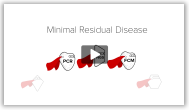Because of acute lymphoblastic leukemia's (ALL's) rapid growth, most patients need to start chemotherapy soon after diagnosis.
Chemotherapy drugs kill fast-growing cells throughout the body including cancer cells and normal, healthy cells. The damage to normal, healthy cells can cause side effects. Yet, not everyone experiences side effects the same way.
ALL treatment consists of:
Induction Therapy
The first phase of treatment is induction therapy. The goal of induction therapy is to destroy as many cancer cells as possible in order to achieve (induce) a remission. Typically, initial therapy requires a hospital stay of 4 to 6 weeks.
Induction regimens for ALL generally use a combination of drugs that include
- Vincristine (Oncovin®)
- Anthracyclines (daunorubicin [Cerubidine®], doxorubicin [Adriamycin®])
- Corticosteroids (prednisone, dexamethasone)
Doctors may add additional drugs to induction based on the patient's prognostic factors.
At the end of induction therapy, doctors will check to see whether the patient has achieved a complete remission. A complete remission is achieved when
- No more than 5 percent of cells in the bone marrow are blast cells
- No blasts are found in the blood
- Blood cell counts are back to normal
- All signs and symptoms of ALL are gone.
To see a list of standard drugs and drugs under clinical study to treat ALL, order or download The Leukemia & Lymphoma Society's free booklet Acute Lymphoblastic Leukemia (ALL) in Adults
![]() For information about the drugs listed on this page, visit Drug Listings.
For information about the drugs listed on this page, visit Drug Listings.
Minimal Residual Disease (MRD)
Even when a complete remission is achieved, some leukemia cells that cannot be seen with a microscope may still remain in the body. The presence of these cells is referred to as “minimal residual disease (MRD).” Patients who have achieved remission after initial treatment for this type of ALL, but have MRD are at increased risk of disease relapse.
It is important to get tested for MRD after achieving remission. The tests used most often to detect MRD are flow cytometry, polymerase chain reaction (PCR), and next-generation sequencing. These three tests typically use samples of bone marrow cells, but in some cases blood samples can be used. The tests are much more sensitive than standard tests that examine cell samples with a microscope. It is often recommended that MRD testing be done after the completion of induction therapy. Recommendations for additional MRD testing depend on the treatment regimen used.
For patients in remission but who test positive for MRD, blinatumomab (Blincyto®) may be prescribed.

Consolidation
The second phase of chemotherapy is called “consolidation” therapy or "intensification" therapy. The goal of consolidation is to kill any remaining leukemia cells.
Consolidation treatment is often based on whether the patient is MRD positive after induction. For patients with B-cell ALL who are MRD positive, Blinatumomab (Blincyto®) is often the recommended treatment.
For patients who are MRD negative after induction, consolidation is typically combination chemotherapy. Depending on the treatment regimen used, consolidation chemotherapy may use different drugs than those given during induction or some of the same drugs.
As part of consolidation therapy, some patients in remission may receive a stem cell transplantation.
Maintenance
The third phase of ALL treatment is called “maintenance.” The goal of maintenance therapy is to prevent disease relapse after induction and consolidation therapy. Most maintenance drugs are given orally and, typically, patients are treated in an outpatient setting. They receive lower doses of chemotherapy drugs and, as a result, tend to have less severe side effects. In some cases, chemotherapy also includes drugs that were not used during induction treatment.
Most maintenance regimens include
- 6-mercaptopurine (administered daily)
- Methotrexate (administered weekly)
- Periodic doses of vincristine and corticosteroids
Central Nervous System (CNS)-Directed Therapy
ALL can spread to the central nervous system (the brain and spinal cord). A lumbar puncture (also called a spinal tap) is used to check the spinal fluid for ALL cells. At the time of diagnosis, it is uncommon for leukemia cells to be found in the central nervous system, occurring in only 3 to 7 percent of cases. Even if ALL cells are not found in the spinal fluid, CNS prophylaxis is administered to prevent leukemia cells from spreading to the area around the brain and the spinal cord and is typically given to all patients throughout the entire course of ALL treatment—during the induction phase, the consolidation phase and the maintenance phase.
Central nervous system-directed therapy may include:
- Intrathecal chemotherapy: In this treatment, chemotherapy is injected directly into the spinal canal.
- Systemic chemotherapy: In this treatment, drugs are given through a vein.
- Cranial irradiation: In this treatment, patients receive radiation therapy to the brain. In most practices, doctors do not routinely use cranial radiation except in patients who already have leukemia cells in their central nervous system. Some regimens for T-cell ALL still use cranial radiation, although this is becoming less common. When radiation is used, the chance of long-term side effects is higher.
Related Links
- Download or order The Leukemia & Lymphoma Society's free booklets
- Chemotherapy and Other Drug Therapies
- Methods to Administer Drugs
- Managing Side Effects
- Integrative Medicine and Complementary and Alternative Therapies
- Food and Nutrition
